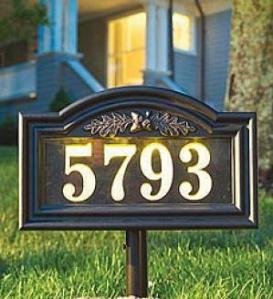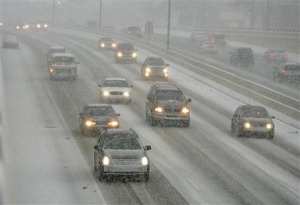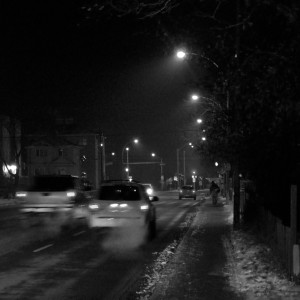|
DontGetHit Archive Page
Thursday, January 31, 2013
 Can Emergency Help Find You? Can Emergency Help Find You?
In
the case of an emergency, you want the rescue workers, whether they are
police, firefighters or emergency medical technicians, to be able to
reach you quickly. These emergency workers depend on your address's
visibility to assist them at critical times. This problem is compounded
at night. Many homes and apartments have addresses that are hidden, have
numbers missing, or are unlit, making them virtually invisible in the
dark. These simple oversights may cause a tragic delay if an emergency
occurs.

Can
your house numbers be seen from the street? Are they on a background
that provides contrast, such as black numbers on white or light numbers
on a dark background? If your house can not be seen from the street due
to trees or a long driveway, is your address prominently displayed on a
mailbox, painted on a curb, or attached to a fence?
If the answer
to any of these questions is “no,” you're placing yourself and your
family in jeopardy. Thankfully, there are some very simple things you
can do to make sure your home is easy to find in the event of an
emergency.
First, look at how your address is displayed. It
absolutely must be visible from the street. The general rule is to have
the numbers and letters in your address at least four inches high to
ensure maximum visibility.
When displaying your address, consider
the background. Black metal numbers on a dark house are practically
invisible, even in broad daylight. Make sure to contrast the address
with the background to make it easier to see and read. You can take this
even further by purchasing reflective letters and numbers or lighted
numbers. This gives your address more chance of being seen easily in the
dark.
If your address is displayed on your mailbox, make
sure it is in good repair. Check regularly to ensure no numbers or
letters have fallen off or faded due to weather.
Are there trees,
bushes, or shrubs covering your address? Prune them back so the address
can be seen. Make this part of your regular yard maintenance to ensure
the address stays visible.
One address sign is not enough. Place
one next to the front door, one on either side of your mailbox, one on
the curb (if your area allows this) and one on any prominent yard
decoration such as a lantern.
Reflective numbers are best for
placing on a curbside mailbox or other smooth surface near the street.
Lighted numbers are best to place near your door.
These quick and simple tasks can ensure that if an emergency occurs, help won't be delayed because of a hidden address Its all about your safety!
DontGetHit.com
 
Wednesday, January 23, 2013
 Night Driving Tips Worth Knowin Night Driving Tips Worth Knowing
The
National Safety Council says that night-time traffic mortality rates
are three times as high as those for daytime. Still, many remain in the
dark about the specific hazards tied to night driving. Some just plainly
don't have a clear idea how best to deal with such threats.
Driving Safe at Night
Why
is it so dangerous to drive at night? The darkness is one obvious
reason. Around 90 percent of drivers' reactions are hinged on vision,
which is severely impaired at night.  Once
the sun sets, color recognition, peripheral vision and depth perception
become compromised. It is harder for older drivers to see anything at
night. Fifty-year-olds need two times more light than 30-year-olds.
Fatigue
is yet another factor contributing to the dangers of night-time road
cruising. Drowsiness dulls concentration and slows a person's response
times. All these make for a difficult drive. There's also alcohol
that is responsible for nearly half of all fatal vehicular crashes. This
explains why it's riskier to drive on weekend nights. A great number
of automobile mishap-related deaths happen on weekend nights.
The
good news is there are effective ways to reduce after-dark hazards. It starts with proper preparation of the car and heeding certain guidelines when driving.
Be prepared, check your fluids and make sure all your lights are working correctly. It is important to also keep a flag or emergency light in your car to worn drivers of a distressed car. Extra gas in a gas canister is a must.
When driving follow the steps mentioned below from the
NSC.
1. Headlights aimed properly – Faced the wrong way,
headlights blind other motorists (drivers) and limit ability to view the
roads. 2. No smoking while driving – The carbon monoxide and nicotine in cigarettes impair vision at night.
3. Lower speeds while increasing the following distance – This helps
plenty in judging how far and fast other vehicles are going at night.
4. Low-beam the headlights – When there's another car in front, avoid
blinding the driver by maintaining headlights at low beams. 5. Have
periodic breaks while driving – If exhausted from the drive, stop, pick
up some snacks, rest and maybe exercise a bit to re-energize. 6. Ready the vehicle for evening drives – Keep tail lights, headlights, windows and signal lights clean all around.
7. Drive only when sober – Alcohol seriously hampers driving abilities
and depresses the system. A single drink can trigger fatigue so don't
mix driving with drinking. 8. When in doubt, turn headlights on –
This is more to help other drivers see you coming than improving your
own vision during the twilight hours. Visibility is very important.
9. Never over-drive headlights – You ought to be able to halt within the
illuminated region. Otherwise, you're likely to create an area in front
of the car for blind crashes. 10. Avert gaze from oncoming bright
beams – If approaching vehicles don't lower their beams, avoid the glare
and stay on the correct side of the road by focusing on the road's
right edge. 11. Car trouble? Pull over – If your vehicle acts up,
pull as far off the street as possible. Set up reflective triangles near
and 300ft behind the car immediately to warn incoming traffic. Activate
dome lights and flashers, move passengers away and avoid the roadway.
Drive
safe at night by practicing the above safety reminders. Dusk until dawn
is the toughest time for driving. The eyes are busy adapting to the
increasing darkness so exercising care when night driving is always
smart.
DontGetHit.com
 
Wednesday, January 16, 2013
 Driving
in unpleasant weather is no picnic, whether it's simply to the grocer's
or across different states. That's why it pays to have a well-prepared
car. Seeing to it that the vehicle is ready for whatever climets show up
and not rushing to get to a destination will ensure that you and your
vehicle arrive safe and in one piece.
Traveling Safe in Winter
The
AAA and Department of Transportation offer several tips to make winter
travels safer. See to it that the following are taken care of:  Car Care Essentials:
Car Care Essentials:
1. Always have the gas tank half-full. This prevents moisture from accumulating and becoming frozen in the gas tubes or lines.
2. Check the battery connections. They have to be clean and secure. Batteries older than three years should be replaced.
3. Make a safety kit for winter. It's a box containing spare batteries;
a flashlight; one sleeping bag or blanket; extra hats, rain gear, socks
and gloves; one sack of non-clumpy kitty litter or sand for traction in
case you are trapped in snow; jumper cables; a big bright-colored cloth
to serve as flag; bottled water; non-perishable foods, one small kit
for tools; and a first-aid kit.
4. Check the car. See that the windshield wiper fluid and anti-freeze are enough.
5. Make sure tires are inflated properly and frequently. Icy
temperatures can cause the tire air pressure to drop, affecting handling
and traction.
6. Clean lights and mirrors. See that the lights are all aimed right.
Pre-departure reminders:
1. See
to it that all roads included in your trip route are open and passable.
The US Department of Transportation Federal Highway Administration
website www.fhwa.dot.gov/trafficinfo provides updates to keep you
posted.
2. Warm up the vehicle in open areas. The garage and other enclosed parking places aren't the best for warming up cars.
3. When taking trips or passing through remote locations, inform
friends or family where you plan to be. Let them in on the route to be
taken and estimated arrival time.
The actual trip heads-up:
1. Keep headlights turned on.
2. Raise stopping distances between the vehicle ahead and you.
3. Be on the lookout for drivers who could be having issues with roadway conditions.
4. If feeling uncomfortable about driving, find a secure place and park there for a while.
5. Always buckle up.
6. Slow down, please. Gradual acceleration and deceleration is best. Refrain from frequent use of the cruise control.
7. Never pass other cars on or when close to bridges.
Keep all these safety measures and
you're sure to arrive at your destination with everything intact. They
can spell the difference between a great trip and an unfortunate,
regrettable, mishap-ridden outing.
DontGetHit.com
 
Monday, January 07, 2013
 Keeping Safe While Winter Night Walking or Biking Keeping Safe While Winter Night Walking or Biking
When
it gets dark, walking and running safely pose a challenge. However,
this doesn't mean people should give up all nightly activity. Thanks to
numerous safety tips out there, it is still possible to go out at night
for a jog or stroll.
How to Have Safe Walks At Night
Winter
has shorter days. Busy work schedules make it impossible for people to
run, bicycle or walk when it's midday. They're forced to move their
workout routines in the wee morning hours before heading to the office,
or after work, which is sometime in the evening.  In
summer, it's still bright during such hours, but come wintertime, the
days shorten and people have to move their riding or exercise activities
to when it's dark and danger lurks everywhere.
If
you are looking for sound advice on how to see and be seen when night
falls, consider the info below. They apply to pedestrians and bicyclists
alike.
Seeing
Runners - Bicyclists, walkers and runners need to see as well as be
seen while cloaked in darkness. Having a clear vision of things will
help avoid falling into potholes, tripping over obstacles and other
related road hazards. If you are visible, there's little possibility of
getting hit by drivers.
Being
Seen - Bring along flashlights. Go for modern LED or a bright small mag
light / mini size light. They're compact while still delivering ample
light. People who can't be bothered with carrying along things can
simply strap on headlamp flashlights.
Don
reflective clothes – Stick with lighter shades as darker colors reflect
less light. Even better: use advanced ultra-reflective garb. These
maximize evening visibility.
Several high-technology reflectivity options include:
1. Reflective tape – It reflects light toward the source. Apply generously on exercise outfit. Drivers won't miss such noticeably bright hues.
2. Reflective exercise clothes – Most exercise apparel firms have lines
made from extremely reflective fabrics. They're often marketed as
exercise wear that double as bicycling, walking or other workout
apparel. The clothes are easy to see at night and keep its wearer warm
during winter. 3. Reflective safety vests – Highway workers wear
similar pieces. People can wear them on top of exercise garb so drivers
see clear human outlines. They can be worn over different exercise
clothing without need for alterations. 4. LED safety lights – Add this to any of the above options to up visibility.
Other suggestions:
1. If taking walks with kids after meals, warn them to be careful with traffic.
2. If the community struggles with crime, observe the same vigilance
for after-dark exercise as other night-time activities. Stay away from
dangerous neighborhoods and have companions when running (canine or
human).
3. Walk or run at tracks or parks nearby to minimize contact with traffic.
Taking
self-defense classes is another suggestion. Aside from being a good
source of exercise, it will give those concerned about crime risks more
security. Keep in mind, regular runs or walks mean you're probably in
great shape to chase and outrun criminals. You don't have to abandon all
plans of running, biking and walking just because it's winter. Just
take the necessary precautions and you can continue enjoying your daily
exercise regimens.
DontGetHit.com
 
Thursday, January 03, 2013
When it comes to being safe, we say better safe than sorry. So why not stay as protected as possible? If you want to be seen in the dark, you don't have to look like a weirdo, there are plenty of stylish reflective accessories and clothing and outwear that incorporate reflective material.
When walking, jogging, or cycling safety belts or vests are the most important. However, there
are a number of items that can increase the visibility of drivers as well.
For example, one can wear reflective slimbands around their ankles or as chain guard to secure their pants when cycling. There are also reflective armbands
which can be worn on your arm, some even have flashing LED lights for great side visibility. Cool reflective slap bracelets can be
fun for even the young. Reflective shoe pockets are practical and will keep you visible all the way down to your toes.
You can keep your family and friends safe too by giving them inexpensive reflective party favors like
stickers, keychains, hangers and zipper pulls.
There are many more accessories that can be used for children, pets and much more. Please share with us your "bright" and fun ideas on how to be visible and safe.
DontGetHit.com
 
|